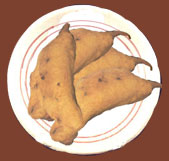Mirchi Bada
 Mirchi Bada | |
| Alternative names | Mirchi bhaje, Mirchi bhajia, Mirapakay bajji |
|---|---|
| Course | Snack |
| Place of origin | India |
| Region or state | Jodhpur, Rajasthan[1] |
| Associated cuisine | Indian |
| Serving temperature | Hot or warm |
| Main ingredients | Green chillies, gram flour, potatoes |
Mirchi Bada or Mirchi Vada is a vegetarian fast food dish native to Jodhpur in the Indian state of Rajasthan.[2][3] The dish is made by stuffing a green chili with indian spices, mashed potato, and gram flour, then it is wrapped in besan batter and fried until golden brown.[4] It is served hot with tomato sauce or occasionally with mint and tamarind chutney. Banana pepper and Bhavnagri chillis are used for making mirchi bada.[5]
Mirchi Badas are most consumed during the rainy season in india.[6] In the southern part of India, Mirchi Bada is also referred to as Mirchi Bajji, with stuffing variations from place to place.
Preparation
It is prepared by halving a mirchi (banana pepper), filling it with spices, a coating of mashed potatoes, and gram flour. Initially, the green chili is fried alongside the potatoes and spices, and subsequently, it is deep-fried with a layer of gram flour coating. Then it is served hot with ketchup or chutneys.[5]
Variation
One variation of Mirchi bada is Mirapakay bajji from Telugu states.[7]
References
- ^ "Rajasthani Mirchi Vada Recipe by Niru Gupta". NDTV Food. Retrieved 5 May 2024.
This is a popular street snack of Rajasthan also known as Jodhpuri Mirchi Vada
- ^ "Rajasthani Mirchi Vada Recipe by Niru Gupta". NDTV Food. Retrieved 5 May 2024.
- ^ "Rajasthani Cuisine". Rajasthan Tourism.
- ^ "Mirchi Bada". INDIAN CULTURE. Retrieved 20 October 2023.
- ^ a b "Jodhpur eats one lakh Mirchi Vada per day! Know more about traditional Rajasthani snack". Financialexpress. 2 August 2019. Retrieved 21 October 2023.
- ^ "Jodhpur eats one lakh Mirchi Vada per day! Know more about traditional Rajasthani snack". Financialexpress. 2 August 2019. Retrieved 7 May 2024.
- ^ K, Lim T. (30 January 2012). Edible Medicinal And Non-Medicinal Plants: Volume 2, Fruits. Springer Science & Business Media. ISBN 978-94-007-1764-0.

